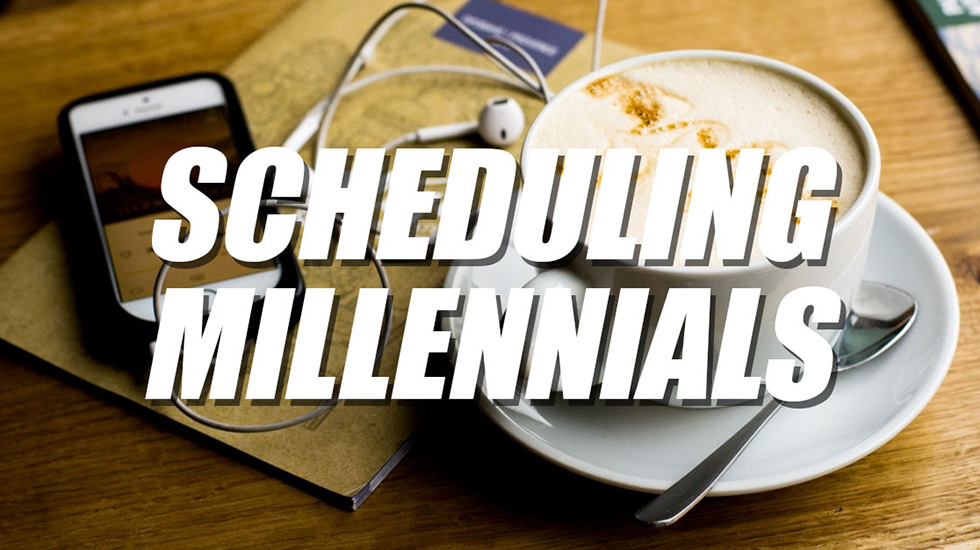Resources > Blog > Everything You Need to Know About Scheduling Millennials
Whether you manage a downtown coffee shop, run a community library or supervise the volunteers for a city's annual marathon, chances are you employ at least a few 18-to-34 years olds. If you don't happen to have any Millenials on your staff at the moment, you will soon.
That's because, as of 2015, Millennials are the largest working generation working. It's estimated that they will soon make up almost 80% of the total workforce. The best employee policies treat all your workers equally, regardless of whether they're Generation X, y, or baby boomers. But, Millennials are changing the workplace, and for small businesses, adaptation is necessary.
Making your workspace more Millennial-friendly could take many forms: remote working options, nap spaces, or Taco Truck Thursday company lunches. Not all of these, however, are feasible for most businesses. Instead, there's one key area in particular that can both save you time and make your millennial workforce feel more autonomous: scheduling.
Traditional scheduling doesn't work for most Millennial employees, but making simple, strategic changes to implement social scheduling can help. Social Scheduling is the ability to add, drop, and swap shifts with coworkers. This creates a workforce of available and ready-to-work employees, while ensuring coverage for managers and empowering employees.
Social scheduling will help you better attract, manage, and maximize Millennial employees because:
- Most Millennials rely on their phones for communication - and not for phone calls.
- Millennial employees value flexible work schedules.
- Millennials are more connected to their coworkers and managers that older generations.
- Millennial workforces value collaboration over competition.
- Social scheduling builds trust and empowers millennial employees.
Take a closer look at each of these points to learn more about scheduling millennials.
Most Millennials Rely on their Phones for Communication - But Not for Phone Calls
Shift-swapping used to require grabbing the employee phone tree and dialing around until you reached a coworker able to take your shift. Today, this just wouldn't work.
About half of Millennials rely exclusively on their cell phone and don't have access to a landline. Even more, Forbes points out that most Millennials don't use cell phones for phone calls. Instead, they use their devices for text or email, forms of communication that require less interruption.
Social scheduling allows your employees to pick up, drop, or swap shifts the same way, without interruption to their day.
Millennial Employees Value Flexible Work Schedules
Millennials are vocal about wanting more flexible work schedules. Flexible schedules can allow employees to work altered hours that can help them better balance outside obligations and maximize productivity.
Of course, flexible work schedules aren't possible for every business. If you need six baristas to cover the breakfast rush, you can't afford to have employees to come in later than their scheduled shift, even if it would make them more productive.
What you can do is implement social scheduling.
This allows your employees to adjust their work schedule as needed to make sure they're working the best hours possible. Employees can swap or trade shifts, and employees can also update the hours they're available to work. This allows them the flexibility to change and adjust their own schedules, all while maintaining necessary coverage.
Millennials are More Connected to Their Coworkers and Managers that Older Generations
If traditional shift-swapping involved print-outs, phone trees, and some rotary dialing, it also included waiting. Whether this was waiting to start your call, waiting for a co-worker to return your voicemail, or waiting for your manager to approve the swap, the delay made swapping shifts a time-consuming process.
Today, millennial employees are connected to an average of 16 people at work. With more than a dozen potentials a quick text or direct message away, a delay in finding coverage seems unnecessary- and the traditional methods for swapping shifts seems outdated and inefficient.
Social scheduling allows your employees to access their schedules quickly and easily from the SubitUp app on their phones, making shift swapping a quick and painless process.
Millennial Workforces Value Collaboration Over Competition
Competition can motivate your employees, sure. They might improve performance in attempts to outshine their peers. But this can also create a tense - or worse, contentious - work environment. Traditional coverage methods can also breed competition by creating hierarchical systems. On-call employees are always stuck with the least wanted shift; newer employees are expected to cover last-minute for their veteran peers; openers won't swap with closers.
According to Inc.com, 88% of millennials prefer a collaborative workplace culture rather than a competitive one. Social scheduling is, by definition, a collaborative approach to coverage. Employees can request for someone to swap shifts in the app when they need to trade hours. This avoids hierarchical competition and fosters a culture of teamwork.
Social Scheduling Builds Trust and Empowers Millennial Employees
Empowering your employee to take charge of their own scheduling takes this duty off your plate, which is certainly a benefit. More importantly, though, this sends a clear message to your employees that you trust them. Building trust and empowering your employees is key for millennials, who are more loyal to their employers than previous generations of workers.
Social scheduling allows employees to report hours and swap shifts easily on their phone, replacing traditional coverage plans for a more efficient, employee-managed model. With a growing millennial workforce, this change in process is even more important.
***
With social scheduling through SubItUp, you can have your employees submit their own availability and manage their own coverage. This allows your employees to participate in their own scheduling; even more, this enables them to take charge of their own scheduling.

















